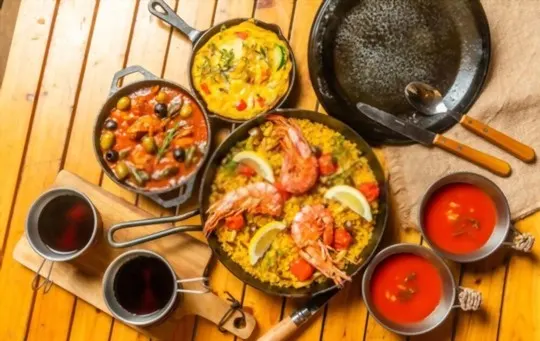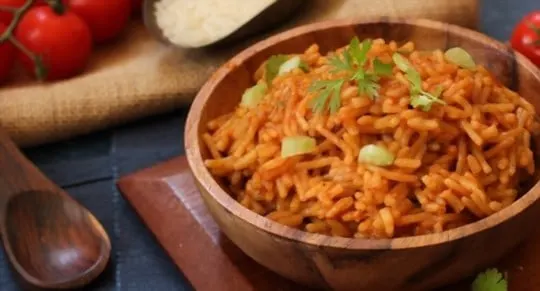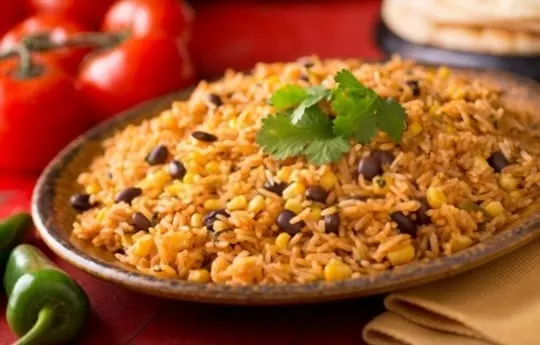Alright, so here’s the deal. We’ve all been there, staring at a menu, trying to pick between Spanish Rice and Mexican Rice. It’s like choosing between Marvel and DC. Both have rice, tomatoes, and that kick we love. Yet, they’re not twins. Distinct flavors, friends.
Now, our last family dinner? A scene. My cousin, a self-proclaimed food critic, claimed he could out-cook any chef on these two dishes. We laughed until we cried. Here’s why that matters.
Both dishes bring their own zest to the table. Spanish Rice, with its bold, saffron-infused aroma, travels straight from Spain. Mexican Rice? It’s the party starter, packed with cilantro and lime.
We’re here to break it down for you. No fluff, just the tasty truth.

What is Spanish Rice?

Spanish Rice is a popular dish in the Spanish-speaking world, known for its rich and flavourful taste.
This rice is traditional to Spain and has now spread throughout the globe thanks to globalization.
- It refers to a rice dish cooked with tomatoes, onions, garlic, and sometimes bell peppers and other spices.
- Spanish rice can be made with either white or brown rice, depending on one’s preference.
- This rice is different from paella as paella is more of a seafood dish originating from Valencia.
Spanish rice is versatile enough to be served both as a side dish or as the main course.
The traditional recipe has been modified several times over the years, creating variations that reflect different regional tastes.
What is Mexican Rice?

Mexican Rice is a popular side dish in Mexican cuisine that is characterized by its red color and smoky flavor.
It is usually prepared by sautéing onions, garlic, and tomatoes in oil or lard before adding long-grain rice to the pot.
The rice is then simmered with chicken stock or tomato sauce until tender and infused with a vibrant flavor.
Mexican Rice can also be enhanced with spices like cumin and chili powder, making it a versatile dish that complements various main dishes.
Differences Between Spanish Rice and Mexican Rice

Spanish and Mexican rice are two rice dishes that are often confused with each other, but there are notable differences between them.
Spanish rice is a flavorful side dish made from white rice, tomatoes, garlic, onions and chicken broth.
On the other hand, Mexican rice (also known as arroz rojo) is cooked with tomato sauce and various spices like cumin and chili powder.
Apart from the main ingredients used in both dishes, another significant difference is the texture of the two dishes.
Spanish rice is typically fluffy and light while Mexican rice tends to be slightly clumpy or sticky due to the use of tomato sauce.
Both dishes have their unique flavors and taste profiles but can be paired well with similar dishes like burritos, enchiladas or tacos.
In some cases, Spanish rice may be used as a base for paella, a popular Spanish dish that often includes chicken or seafood like shrimp.
In summary, while Spanish and Mexican rice may sound similar due to their shared use of many ingredients like tomatoes and onions, they are distinct dishes with different flavor profiles.
Understanding these differences will help you choose which one would best suit your culinary preferences.
Origin and Cultural Influence
Spanish and Mexican cuisine includes a wide range of flavorful dishes.
Both the cultures originated from a similar base but have evolved differently over time.
Spain is known for its influence on Mexico’s culture, including its food style.
This adaptation brought new ingredients like rice, tomato sauce and chili powder to the Mexican culinary world.
When it comes to rice dishes, both Spanish and Mexican are often misunderstood.
Spanish Rice usually contains saffron and chicken broth in seafood paella, while Mexican Rice includes tomatoes and peppers with cumin and chili powder in most dishes.
The use of unique spices make them different from each other.
Mexican cuisine had roots in Mayan cuisines whereas Spanish cuisine developed as a result of various influences from ancient Rome, Catholicism, Islamic Moors, among others during medieval period.
Ingredients and Seasonings Used
This article explores the different ingredients and seasonings used in Spanish rice and Mexican rice.
Both rice dishes are flavored with unique spices and herbs that reflect the diverse culinary traditions of their respective countries.
While Spanish rice typically incorporates saffron, garlic, and other Mediterranean influences, Mexican rice features a variety of chili peppers, cumin, and tomato-based sauces.
The subtle variations in flavors reveal the cultural histories that have shaped these recipes over time.
Flavor and Aroma
The taste and aroma of Spanish rice and Mexican rice are distinct from each other, making it challenging to choose between them.
Spanish Rice’s flavor profile is more savory, nutty, and rich because of the inclusion of tomatoes, onions, and garlic in its recipe.
On the other hand, Mexican rice has a slightly tangier taste due to the blend of chicken broth, tomato sauce or paste, cumin, and chili powder.
Both these rices have an appetizing fragrance that enhances their overall appeal.
The ingredients used in both dishes for their unique flavor profile play a significant role in determining which one is better suited for individual tastes.
Spanish rice offers a more robust flavor that complements heavy entrees like beef or chicken.
Meanwhile, Mexican rice’s slightly acidic taste makes it perfect for pairing with spicier foods like tacos or enchiladas.
However, the choice ultimately comes down to personal preference.
It’s important to note that the preparation methods also influence the final outcome of both rices’ flavors and aroma.
The cooking time and proportion of water vary from one recipe to another.
Chefs often toast their rice grains before adding water to give it a nuttier taste and enhance aroma.
Cooking Methods and Techniques
Spanish and Mexican Rice are two beloved dishes that have been around for ages.
Both rice dishes rely on varying methodology in their preparation.
The Spanish often use saffron as one of the main ingredients to give their dish a slightly sweet flavor and golden hue, while their Mexican counterparts add tomatoes or tomato sauce to their rice which produces a deeper color and more robust taste.
Cooking time and temperature also differ according to each recipe.
In general, Spaniards cook their rice by simmering it slowly before adding other ingredients, while Mexicans prefer boiling it vigorously at first then reducing heat and simmering thereafter.
Spanish Rice has quite a distinct flavor from Mexican Rice.
Apart from Saffron seasoning in the former, garlic, onions, cumin or paprika may be added depending on regional nuances or food affinity of the cook themselves.
For Mexican rice, the key ingredients are uncooked long grain white rice boiled with olive oil and chicken broth alongside chopped vegetables (tomatoes being an essential), whereas spices like chili powder could be easily identified too.
Depending on preference or intent for those preparing these dishes, there is no difference between the physical appearance of both recipes since they can look almost similar even if presented in different serving styles or sizes.
In general, we can note that both Spanish and Mexican cuisine celebrate deliciousness flavored with natural herbs across all types of cuisines and putting them together seems perfect for those who want to experience some diversity in their cooking adventure.
Similarities Between Spanish Rice and Mexican Rice

Spanish Rice and Mexican Rice share several similarities, including the basic ingredients of rice, tomatoes, onions, garlic and sometimes chili peppers.
Both rice dishes also often feature chicken broth as a key component in their preparation methods.
In terms of texture and overall taste, Spanish Rice and Mexican Rice are comparable in their ability to produce slightly crispy grains with fluffy centers.
Additionally, they can both be easily prepared as vegetarian options for those who do not consume meat-based products.
When it comes to differences between the two rice dishes, Spanish Rice generally includes saffron as a flavoring agent that imparts a distinct yellow hue to its grains.
The use of saffron is not typically found in traditional Mexican Rice recipes.
Furthermore, Mexican Rice usually incorporates cumin as a spice within its preparation process.
This ingredient offers a smoky flavor that serves to distinguish it from Spanish Rice varieties.
Regional Variations of Spanish Rice and Mexican Rice
Spanish and Mexican rice are popular dishes that have unique regional variations.
The flavors, ingredients, and cooking methods differ in both cuisines.
Spanish rice is commonly found in Spain and Latin American countries, while Mexican rice is a staple in Mexico.
In Spanish cuisine, yellow or saffron rice is a common variation.
It’s made by frying the rice with onions, garlic, and spices before adding stock or tomato sauce to cook it.
The result is a flavorful, fluffy dish that’s perfect as a side dish or main course.
On the other hand, Mexican rice is often served as a side dish alongside beans or meat dishes.
It’s typically prepared by simmering white rice with tomatoes, onions and garlic until the liquid is absorbed.
Both regional variations of rice have unique spice blends depending on the preference of the cook.
Moreover, other ingredients like peas or bell peppers may be added for enhanced flavor in both Spanish and Mexican cuisines.
While Spanish and Mexican Rice are popular dishes globally renowned for their uniqueness of preparation from region to region, it’s important to note that they both have excellent nutritional qualities due to the variety of ingredient selections made available when making them.
Serving Suggestions and Pairings
When it comes to serving suggestions and pairings, both Spanish rice and Mexican rice complement a range of dishes.
Their versatility allows them to be served alongside various meats, vegetables or used as a base for burritos or wraps.
Spanish rice enhances the flavor profile of seafood dishes while Mexican rice is perfect with hearty beef stews or grilled chicken.
Furthermore, both Spanish and Mexican rice can be paired with margaritas or any other flavored drink to balance out their spicy flavors.
Opting for beer is another popular choice when serving these rices along with your favorite Mexican dish.
Pairing either of these rices with black beans or refried beans will elevate the taste experience even more.
Conclusion
Comparing Spanish rice and Mexican rice is not about finding out which one is the better option, but rather understanding their difference in taste, texture, and preparation.
While Spanish rice is cooked with saffron and broth, Mexican rice is made with tomato sauce and spices.
Moreover, Spanish rice has a more delicate flavor as compared to the bold taste of Mexican rice, which makes it a better option for dishes where you don’t want the flavors to overpower each other.
However, if you enjoy a more robust flavor profile, then Mexican rice would be the perfect choice for your next meal.
In retrospect, both Spanish and Mexican rice are delicious options; it simply depends on your preference.

Leave a comment